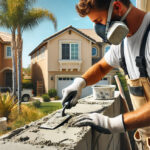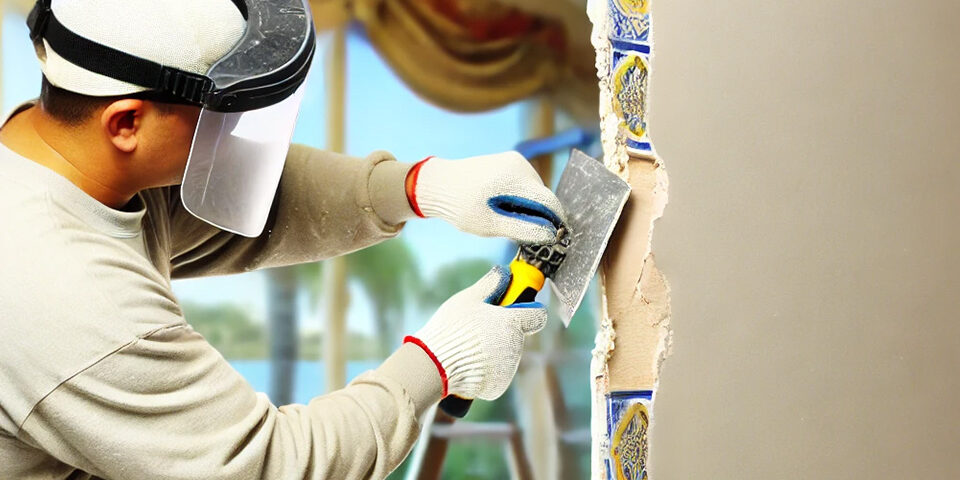
Debunking 11 Common Myths About Stucco Repair in San Diego
July 24, 2024
2025’s Trendiest Colors For Cabinet Painting in San Diego
October 11, 2024When it comes to maintaining a beautiful and well-functioning home, drywall repair is often overlooked—until you notice that annoying crack or hole!
For San Diego homeowners, understanding drywall repair is essential because the local climate, seismic activity, and common wear and tear can lead to various types of damage. This comprehensive guide will walk you through everything you need to know about drywall repair in San Diego, from identifying different types of damage to deciding when it’s time to call a professional—let’s get started!
What are the types of drywall damage?
Before diving into repair techniques, it’s essential to understand the types of drywall damage most common in San Diego homes. Knowing what you’re dealing with can help you determine the best course of action.
1. Minor Damage
Small holes, dents, and dings are often caused by everyday wear and tear. This can include door handles hitting the wall, accidental bumps from furniture, or small nails being removed. Such damages are typically superficial and are relatively easy to repair. While they may not seem urgent, fixing them promptly can prevent further damage and maintain the aesthetic appeal of your home.
2. Cracks in Drywall
Cracks in drywall are also common and can result from various causes, such as the building settling, temperature fluctuations, or seismic activity—especially relevant in San Diego, given the region’s propensity for earthquakes. These cracks can be hairline fractures or more noticeable gaps, but it’s important to monitor them. Small cracks can usually be patched easily, but larger or recurring cracks may indicate a more serious structural issue that needs professional attention.
3. Water Damage
Water damage is a significant concern for San Diego homeowners, particularly during the rainy season or if there are plumbing leaks. Water can cause drywall to become stained, swell, and eventually crumble. This type of damage is more than just an eyesore; it can lead to mold growth, which poses health risks. Repairing water-damaged drywall typically involves replacing the affected sections and addressing the source of the moisture to prevent future problems.
4. Large Holes and Punctures
Large holes and punctures can occur for many reasons, such as moving heavy furniture, children or pets causing accidents, or even during home renovations. These damages are more complex to fix and often require replacing the damaged section with a new piece of drywall. If left unrepaired, large holes can weaken the wall’s integrity and provide a pathway for pests.
5. Mold Damage
In San Diego, where humidity levels can fluctuate and coastal homes are common, mold can be a serious issue. Mold growth on drywall usually results from water damage or poor ventilation. Moldy drywall must be carefully removed and replaced, and the source of moisture must be corrected to prevent a recurrence. Ignoring mold damage can lead to severe health issues, including respiratory problems and allergic reactions, so it’s important to address it immediately.
How do you carry out drywall repair yourself?
While hiring a professional is often the best choice for significant damage, minor repairs can be handled by a homeowner. Here is a step-by-step guide to fixing common drywall issues:
1. Repairing Small Holes and Dents
- Clean the area: Use a utility knife to remove any loose debris around the hole or dent. Make sure the area is free of dust and dirt to ensure proper adhesion of the patching material.
- Apply patch compound: Use a putty knife to apply a thin spackle or joint compound layer over the hole. Smooth it out and feather the edges to blend it with the surrounding wall.
- Sand smooth: After the compound dries, typically 24 hours, use fine-grit sandpaper to smooth the surface. This step ensures that the patched area is level with the rest of the wall.
- Prime and paint: Apply a coat of primer, then paint over the repaired area to match the surrounding wall. This step restores the wall’s appearance and protects it from future damage.
2. Fixing Cracks
- Open the crack: Use a utility knife to create a V-shaped groove along the length of the crack. This removes loose material and creates a space for the joint compound to adhere.
- Apply joint compound: Fill the groove with the joint compound, then press a strip of drywall tape over the compound. The tape reinforces the repair and prevents the crack from reopening.
- Smooth and feather: Apply a second coat of compound over the tape, feathering the edges to blend with the wall. This step may need to be repeated several times to ensure a seamless finish.
- Sand, prime, and paint: Once dry, sand the area smooth, prime, and then paint to match the rest of the wall. This final step completes the repair and restores the wall’s integrity.
3. Mending Water Damage
- Identify and fix the source: Before repairing drywall, identify and fix the source of the water leak to prevent further damage. This may involve repairing a plumbing leak, roof damage, or faulty window seals.
- Remove damaged drywall: Cut out the damaged section using a drywall saw. Remove any insulation if necessary and allow the area to dry completely. Moisture trapped inside the walls can cause further damage and mold growth.
- Install new drywall: Cut a new piece of drywall to fit the hole, attach it to the studs using drywall screws, and tape the seams. Make sure the new drywall is the same thickness as the existing wall for a seamless repair.
- Finish the joint: Apply joint compound to the seams and screw holes, sand smooth, prime, and paint to match the rest of the wall.
4. Patching Large Holes
- Cut a patch: Measure and cut a piece of new drywall to fit the hole. Be sure to cut along the studs for secure attachment. The patch should fit snugly without forcing.
- Attach the patch: Secure the patch to the wall with drywall screws. Make sure the screws are driven just below the surface of the drywall, so they don’t protrude.
- Tape and compound the joints: Apply drywall tape over the seams, then cover with joint compound. Feather the edges to blend with the existing wall.
- Sand, prime, and paint: Once dry, sand the surface smooth, apply primer, and then paint to match the surrounding area.
5. Handling Mold Damage
- Wear protective gear: Use gloves, a mask, and eye protection when dealing with mold. Mold can release spores that are harmful when inhaled, so take proper precautions.
- Remove moldy drywall: Cut away the affected drywall, at least 12 inches beyond the visible mold growth. Dispose of the contaminated material properly to avoid spreading mold spores.
- Clean the area: Disinfect the studs and surrounding areas with a mold-killing solution. This step is crucial to ensure all mold is removed and to prevent a recurrence.
- Replace the drywall: Install new drywall and finish it using the steps outlined above.
What is the cost of drywall repair in San Diego?
The cost of drywall repair in San Diego varies depending on the extent of the damage, the size of the area, and whether you hire a professional or do it yourself.
1. DIY Costs
For a DIY repair, materials like joint compound, drywall tape, sandpaper, and paint may cost anywhere from $10 to over $1,500, depending on the size of the repair. Tools such as a putty knife, utility knife, drywall saw, and sandpaper can cost nearly $100 if you don’t already have them. Remember that your time is also a cost! Even a small repair can take several hours from start to finish, especially if you’re new to drywall work.
2. Professional Repair Costs
Professional drywall repair in San Diego typically charges $50-85 per hour, with a total job cost ranging from a few hundred dollars to over $1,000, depending on the damage. Additional factors such as accessibility, time of year, and urgency can also impact the cost. For example, repairing drywall in hard-to-reach places, such as high ceilings, can increase labor costs.
When should you hire a professional?
While drywall repair in San Diego can be handled by a determined DIYer, there are certain situations where hiring a professional is recommended:
- Extensive damage: For large holes, extensive water or mold damage, or structural cracks, professional expertise is crucial. A professional will have the experience and tools necessary to handle complex repairs safely and effectively.
- Mold issues: Mold remediation requires careful handling and thorough treatment to prevent recurrence. A professional can ensure the mold is fully removed and prevent it from coming back.
- Time constraints: Professionals can often complete the job faster and more efficiently, saving you time and stress. If you’re dealing with a tight schedule or lack of experience, hiring a contractor may be the best option.
- Quality assurance: Hiring a skilled contractor ensures a high-quality finish that blends seamlessly with the existing wall. They can also offer warranties or guarantees on their work, providing peace of mind.
How can you find a reputable drywall repair contractor in San Diego?
Finding a reliable contractor for drywall repair in San Diego involves several steps:
- Check credentials: Ensure the contractor is licensed and insured. In California, drywall contractors need a C-9 Drywall Contractor license issued by the Contractors State License Board (CSLB). You can check a contractor’s license status on the CSLB website.
- Read reviews and ask for references: Look for contractors with positive online reviews. You could also ask for references from past clients to gauge their work quality and professionalism.
- Get multiple quotes: Obtain at least three quotes to compare prices and services. A reputable contractor will provide a detailed estimate that includes labor, materials, and other potential costs.
- Ask about experience and specialization: Choose a contractor with experience in the specific type of repair you need. If your drywall damage involves mold remediation or extensive water damage, find a contractor who specializes in those areas.
Frequently Asked Questions
Below are some commonly asked questions to consider:
1. What is the average lifespan of drywall?
The average lifespan of drywall is about 30-50 years, depending on its quality, installation, and environmental conditions. Proper maintenance, such as addressing moisture issues and minor damages promptly, can extend its life.
2. What are the signs that my drywall needs to be replaced instead of repaired?
Signs that your drywall needs replacement rather than repair include extensive water damage, widespread mold growth, large areas of crumbling or sagging drywall, and multiple or recurring cracks that indicate structural issues.
3. Can drywall damage affect my home’s insulation?
Yes, damaged drywall can affect your home’s insulation. Large holes, cracks, or gaps in drywall can allow air to escape, reducing the efficiency of your insulation and leading to higher energy bills.
Maintain your home’s integrity with drywall repair in San Diego
Drywall repair is an important aspect of home maintenance in San Diego, helping you maintain the aesthetic appeal, structural integrity, and value of your property. Whether you’re dealing with minor dings or significant water damage, understanding the types of drywall damage and repair options can save you time and money.
While DIY repair is an option for minor issues, don’t hesitate to call a professional for more extensive damage. By knowing what to expect in terms of cost, process, and contractor selection, you’ll be better equipped to handle any drywall problems that come your way.
Work with a reliable contractor who offers drywall repair in San Diego today!



